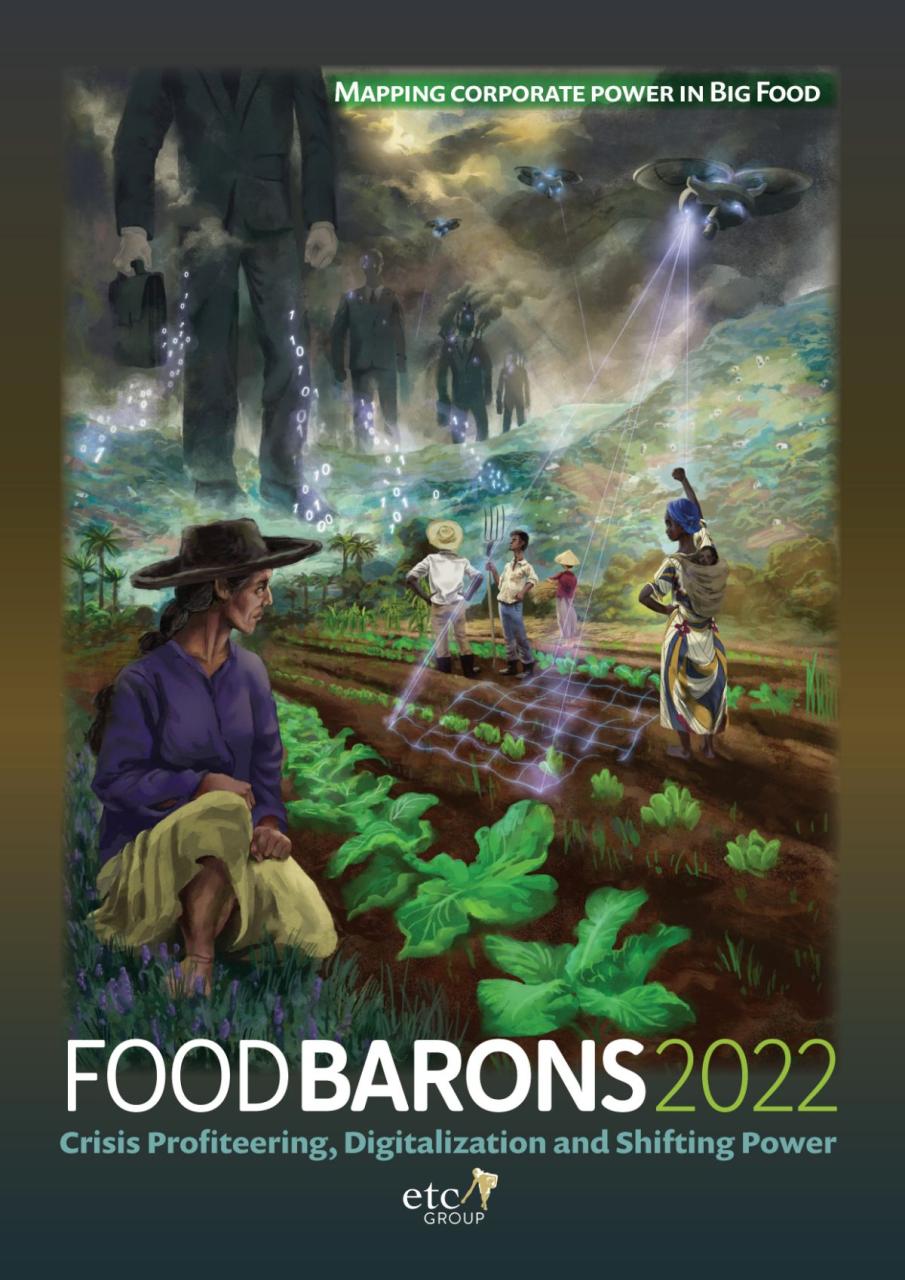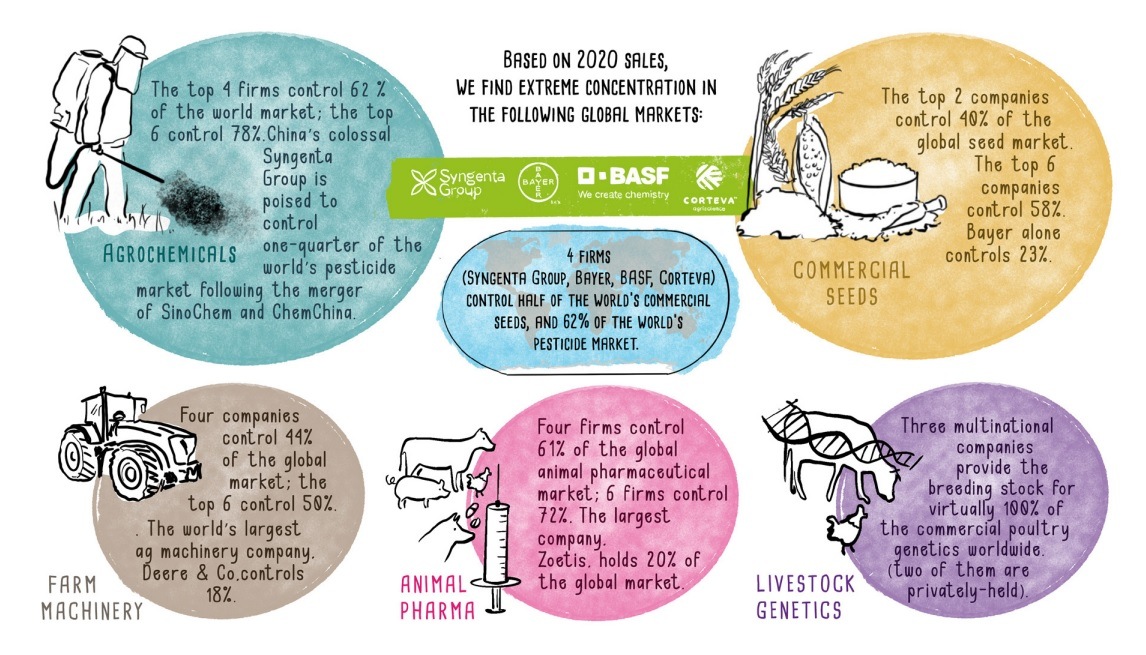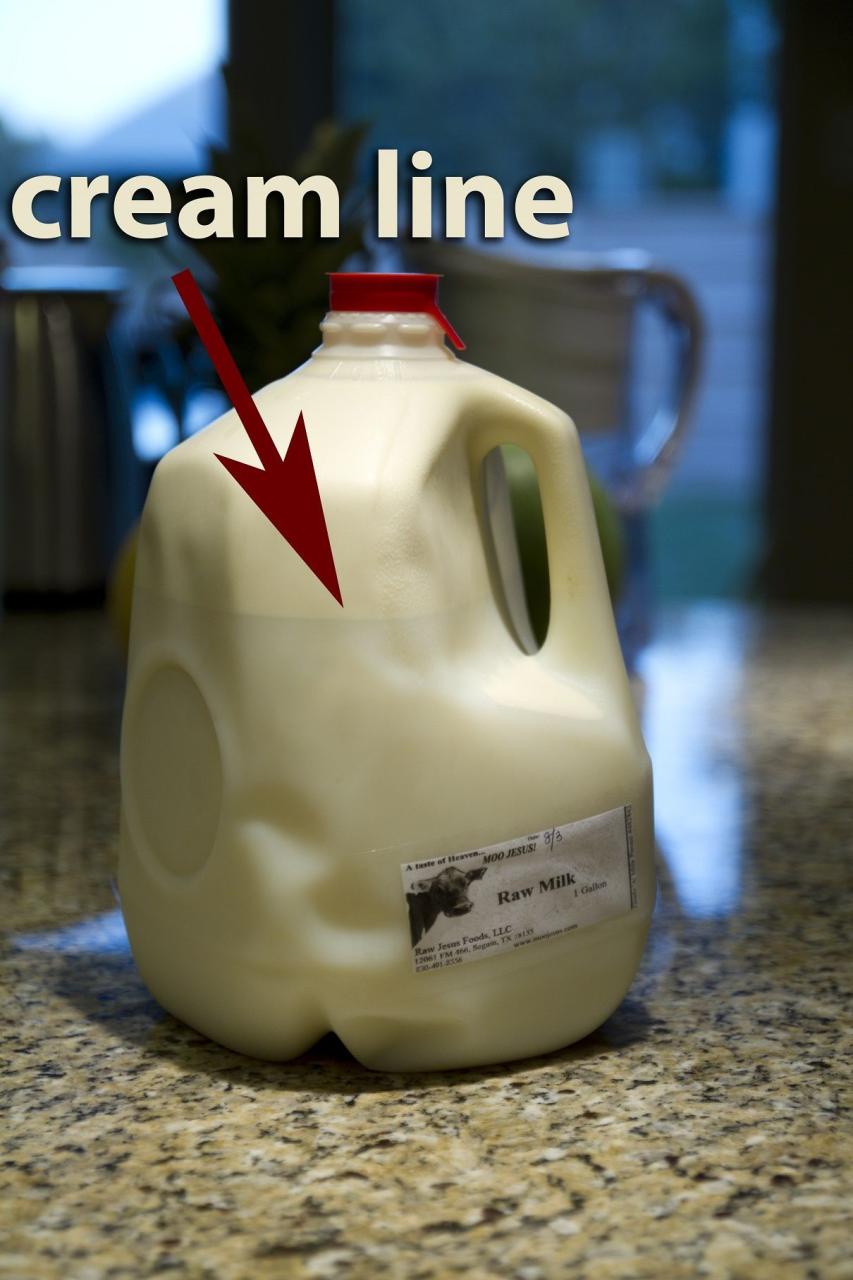The Digitalization of Agriculture: Big Tech’s Plan to Take Over the Food Supply


Comments by Brian Shilhavy
Editor, Health Impact News
As I recently reported earlier this week, everything and anything related to digital computer technology these days is being labeled as “Artificial Intelligence” (AI), the new marketing buzzword for Big Tech to lure money from investors, so it should not surprise us that Big Tech is now attempting to apply AI to food production.
A report published at the end of 2022 by The ETC Group does an excellent job of reporting just how Big Tech is planning on taking over the world’s food supply: Food Barons 2022 – Crisis Profiteering, Digitalization and Shifting Power.
They report:
Power Up: Techno-fixes to lock-in corporate control
The Food Barons are introducing a suite of new technologies and “techno-fixes” that are conceived and designed to entrench corporate control over food and agriculture even further.
They have already wrested control of the agricultural research and development (R&D) agenda to suit their own interests, whilst continuing to concentrate power and influence trade, aid and agricultural policies to fuel their growth and profit.
“Techno-fix” refers to the development of a technology product or intervention to address a social or environmental problem – often a problem created by an earlier technological failure.
Up and down the industrial food chain, the digitalization of food and agriculture emerges as the new techno-fix of the day.
Our ongoing research reveals that every sector of the Industrial Food Chain is in the process of transforming into a digital enterprise.
At the same time, Big Tech is becoming tightly entangled with industrial food production. Data extracted via digital technologies is now itself a commodity: The Industrial Food Chain relies on Big Data to grow, process, trade, track, sell and transport its products.
Digitalizing food and agriculture from farm to front door
The vista of new digital initiatives in food and ag is dizzying.
On the farm, it includes concerted attempts to impose digital agriculture, weaving in drone sprayers, Artificial Intelligence-driven robotic planters and automated animal-feeding operations tricked out with facial recognition for livestock.
Big Ag giants such as Bayer, Deere & Company, Corteva, Syngenta and Nutrien are restructuring their entire businesses around Big Data platforms.
Bayer’s ‘Field View’ digital platform, for example, extracts 87.5 billion datapoints from 180 million acres (78.2 million hectares) of farmland in 23 countries and funnels it into the cloud servers of Microsoft and Amazon.
Deere, the world’s largest farm machinery company, now employs more software engineers than mechanical engineers.
On the route to retail, the global grain trading system is getting a digital overhaul as it becomes increasingly automated and products are tracked via blockchain. At the same time online grocery platforms and food delivery apps (such as DoorDash, Zomato and Deliveroo) surged during pandemic lockdowns and are growing into a whole new ‘last mile’/ last link of the Industrial Food Chain. (Full report.)
This is the reason why billionaire technocrats, such as Bill Gates and Jeff Bezos, are now among the largest owners of farmland in the United States.
This is the future of the technology, and they know it.
As the ETC report so eloquently states, here is the “dream farm” of the Technocrats. It is a “farm of one” where technology does all the work and rakes in the profits:
Every leading agrochemical company offers its own digital ag platform marketed to farmers as a way to transform on-farm data into savings that will ultimately increase farm profitability.
The Holy Grail, they say, is a “farm of one,” where a single farmer/data manager (equipped with many thumbs, perhaps?) can log on to a connected device, watch as the algorithms calculate input prescriptions – based on data collected from in-field sensors and hyperspectral imaging – and then send those prescriptions to a fleet of contracted drones that will dump herbicide, fungicide, fertilizer, growth regulator or other input in a just-right dosage for each plant growing in the field.
Post harvest, the farmer can supposedly sit back and enjoy the profits from increased crop sales and reduced labour costs – as well as from payments for ‘carbon sequestration’ verified by traceability data collected and stored on a blockchain.
With Big Tech’s encroachment into agriculture, we have now moved from Is this food safe to eat? to Is this even “food” and is it edible?
The sad thing is that most Americans today, where now the majority of the population has grown up in the Big Tech era, don’t even care where their food comes from, and if they do get curious, most of them don’t even know what kind of questions to ask.
If it is packaged and sold in fast food restaurants and grocery stores, they just assume it is edible and not something that will poison and kill you, because “they wouldn’t do that.”
But who are “they”? You mean regulatory agencies like the Food and Drug Administration (FDA) that just authorized a population-reduction set of products called “COVID-19 vaccines”?
Nah, of course not. “They” would never allow poisonous, inedible food that harms the public be sold commercially, would they?
“Data is the new soil”
As the ETC report reveals, as consolidated Big Food was before COVID, they used COVID to consolidate even more, so that today just a few corporations control most of the world’s food.
Power Surge: shoring up power and crisis profiteering
When a handful of giant companies are allowed to dominate in uncompetitive markets, with little regulatory oversight, they can and do use their market power to squeeze out competitors, raise prices, hijack the R&D agenda, monopolize technologies (even flawed and ineffective ones) and maximize profits.
Today, amid ever-increasing corporate concentration and anemic antitrust regulation, some of the world’s largest companies are using pandemic-induced supply chain gridlock and inflation as an excuse to jack up prices: a practice known as “crisis profiteering.”
From Top 10s to Top 4s
Our research reveals that, after decades of consolidation, many Industrial Food Chain sectors are so “top heavy” they are controlled by just four to six dominant firms. Economists typically consider a four-firm concentration ratio of 40% or higher reflective of a sector that operates as an oligopoly. Many of the sectors we monitor are already above that 40% threshold; others are on the verge of passing it.
“When you go from 15 to 10 companies, not much changes…When you go from 10 to six, a lot changes. But when you go from six to four – it’s a fix.”
“Those who have market power can raise prices above what’s considered fair market value…We’re at a point in our market concentrations that we haven’t seen ever before.”
“Data,” supplied by Big Tech and their “AI,” is what allows this tremendous consolidation of power.
Big Ag’s Digital Turf Grab
The world’s largest agrochemical/seed firms have fortified their market control via consolidation and mega-mergers; now they are feverishly investing in high-tech and digital technologies that can further expand their already-solid oligopoly. They are not alone; other corporate titans, sitting atop their own sectors – fertilizer giants, ag equipment manufacturers, big tech – are muscling their way into the digital ag arena.
In the past half-decade, the biggest players in global agriculture consolidated to produce the Fat Four (Bayer, Corteva Agriscience, Syngenta Group/ChemChina, BASF) amid a dramatic onslaught of digital technologies that invite – almost require – cross-sectoral convergence.
“Data is the new soil” – now a common metaphor to suggest digital information’s biquitous and foundational role – also points to the reality that Big Data is becoming the prerequisite, the milieu and the means of producing agricultural commodities. The world’s biggest data companies – Apple, Alibaba, Amazon, IBM, Google, Baidu, Microsoft, among others – are now tightly entangled with industrial food production.
We are Not Without Hope! Make Wise Food Choices!
Dehusking coconuts by hand in the Philippines. Low tech, small-scale producers, high quality food, JOBS! Photo copyright: Brian Shilhavy
Here’s the one little secret about the Food industry that the Globalists hope you don’t realize: They can’t sell their products if you don’t buy them and eat them.
It really is that simple.
Every single human being on the planet has to eat. And everyone, at least those who are not incarcerated in an institution or prison, can choose what food they purchase and eat.
According to the ETC Group, 70% of the world’s population is still fed by small-scale producers, and not Big Food.
Reclaiming Power for peasants, communities and food sovereignty: recognising and challenging corporate hegemony
In contrast to the increasing concentration and power of these giant Food Barons, as detailed in this report, it is important to remember who feeds the majority of the world.
The Peasant Food Web still feeds the equivalent of 70% of the world’s people with less than 30% of the world’s land, water and agricultural resources, even though the Food Barons are trying to extend their tentacles through further land- and water-grabs and technological appropriation of the commons.
The Peasant Food Web provides an essential counterweight to the grim tale of concentration and profiteering that we detail in this report, through its inspiring diversification and proliferating territorial food initiatives that re-distribute and share the inherent power of sun, soil, seed and animals amongst people – providing food to billions.
However, this is not true in the United States, unfortunately.
When I lived in the Philippines in the late 1990s and early 2000s, about 50% of the population was employed by agriculture. This ratio is probably still true in many countries today in Asia and Latin America.
The United States has not seen that kind of ratio of the population employed in agriculture since Abraham Lincoln was president.
Today, less than 2% of the U.S. population is employed in agriculture.
Source: U.S. DEPARTMENT OF AGRICULTURE.
But here’s the good news: the majority of farms in the U.S. today are still small, family farms, even though the large corporate farms produce the most food.
Source: U.S. DEPARTMENT OF AGRICULTURE
Most of these small family farms cannot make a living just on their agricultural products, because they have to sell them to commodity food brokers to get them into the system and go through the supply chain to be sold in retail stores.
Would some of the small farmers rather sell their products locally, directly to the consumer at retail prices, instead of to the commodity food brokers?
Yes, of course they would!
So why don’t they?
Because not enough people will take the time to drive out of the city into the rural areas where these farms exist, to purchase directly from the farm. They would rather just stop at their local grocery store where they can pick up everything they need.
What happens when the grocery store shelves go bare, and there is nothing to buy? Or what happens when the Food Barons raise prices so high, you can no longer afford their highly toxic commodity food?
The only way we are going to resist the takeover of our food supply by Big Tech, is by NOT buying their cheap, toxic products, and taking the time to seek out high quality food that can be bought locally from local producers, most of whom would much rather sell directly to the consumer.
The one area where this has seen some success for the past decade or so, is in the area of raw milk sourced directly from the farm. Most states have laws forbidding the sale of raw milk, while some states allow it, and in some cases they only allow it directly from the farm.
If you have only bought and consumed processed “milk” from a grocery store, and never tasted raw milk directly from the cow, you have no idea what real milk actually tastes like.
Milk that goes into the supply chain is immediately processed, and the highest value of the components of liquid milk is the cream, which is sold and incorporated into other products.
If the liquid processed milk you buy in the store is labeled as “Whole Milk”, it usually means they put some cream back into the milk, about 4%.
But if you buy raw milk directly from the farm, especially if it is from Jersey cows, the cream that separates can be almost one third of the milk!
Here is a picture of some raw milk I purchased years ago at a raw milk dairy in Texas:
Raw milk from grass-fed Jersey cows from Moo!Jesus Dairy in Texas.
But here’s the problem. Most small dairy operations around the country have to enter into a contract with a buyer that comes to their farm and empties their milk tank and then transports it to a warehouse where there are milk pools filled by other dairy producers in the area, before it is processed.
If a farmer starts selling some of their milk directly to the consumers in their area, then they might have a hard time meeting their quota that they have a contract to fulfill by the milk cooperative. And if not enough people in their locality come to the farm to buy their supply, they may be forced to stop selling directly to the consumer in fear of losing their contract.
Conclusion: Do You Want to Eat Food Grown on Local Farms, or Fake Meat and Bugs from a Lab and Genetically Modified “Farm” Food?
So in the end, it really does come down to the consumer, and just how committed they are to supporting their local farmers, rather than supporting Big Ag, and today Big Tech, which is who you are supporting by purchasing all your food at your local grocery store chain.
The ETC report explains where Big Tech is going with food production:
New Techno-Fixes: gene editing and RNA-based pesticide sprays
If the pesticide/seed industry giants can take dominant positions in digital farming platforms and a new generation of gene editing and/or RNA pesticide technologies, they are poised to capture new platforms that could provide new technological lock-ins’ – obliging farmers and end-users to adopt a new and expanded menu of proprietary ag inputs and digital services.
Faced with expiring patents, herbicide-resistant weeds, the rise of generic pesticides, and efforts by some governments (especially the EU) to rein in chemical toxins, agrochemical/seed giants are looking to fortify their oligopoly power with the rollout of novel, proprietary genetic technologies, most prominently: gene editing and RNA-based pesticide sprays.
Although these technologies involve very different techniques, they both seek to concentrate corporate power and reinforce industrial agriculture.
Gene editing: Biotech’s Silver Bullet for Food & Ag
What is gene editing?
Genome editing techniques are a form of genetic engineering (GE) used to alter the genetic material of an organism, plant or animal (including humans) by inserting, deleting or changing the DNA at a specific target site in the genome.
A number of genome-editing technologies are currently being used in food and agriculture. The most well-known among these is the CRISPR-enzyme system (e.g., CRISPR-Cas9, CRISPR-CPF1, etc.) CRISPR stands for Clustered Regularly Interspaced Short Palindromic Repeats, and DNA-cutting enzymes are generally called nucleases.
Other gene-editing technologies include TALEN (Transcription activator-like effector nucleases) and ZFN (Zinc finger nucleases). CRISPR-Cas9 made headlines outside scientific circles in 2020 when the scientists who discovered it (Jennifer Doudna and Emmanuelle Charpentier) won the Nobel Prize in Chemistry.
THANKS TO: https://healthimpactnews.com/2023/the-digitalization-of-agriculture-big-techs-plan-to-take-over-the-food-supply/Source
Related posts:
Views: 0
 RSS Feed
RSS Feed

















 February 10th, 2023
February 10th, 2023  Awake Goy
Awake Goy 




 Posted in
Posted in  Tags:
Tags: 
















